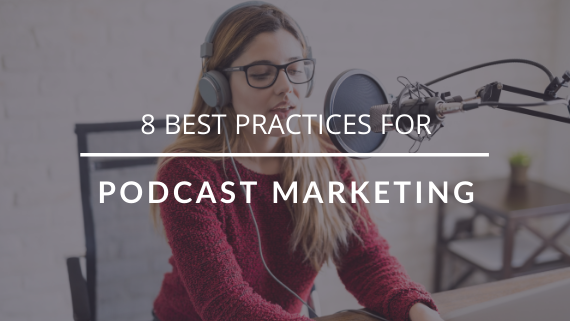For many, the word podcast evokes an obscure image of something that other people, more technically savvy, smarter, and more hip people than you, do in their spare time. Even if you do regularly listen to a plethora of podcasts for your personal enjoyment, have you ever considered the impact of marketing original content through a podcast could have on your business? Perhaps, it’s time.
Powerful Podcast Statistics Business Owners Should Pay Attention To
- There are currently 2 million active podcasts and more than 70 million podcast episodes as of January 2021. (SupplyGem, 2023)
- 75% of the US population is familiar with the term “podcasting” - up from 70% in 2019. (Infinite Dial, 2020)
- More than half of listeners are at least somewhat more likely to consider buying from a brand after hearing its advertisement on a podcast. (eMarketer, 2019)
- 82.4% of podcast listeners spend more than seven hours a week listening to podcasts. (Discover Pods, 2019)
- U.S. weekly podcast listeners averaged six podcasts in the last week. (Infinite Dial, 2020)
- 17% of marketers plan to incorporate podcasts into their content marketing strategy. (HubSpot, 2020)
Podcasting isn’t a new concept or platform in 2021, but it is experiencing a quiet, yet powerful revolution that marketers and business owners should pay attention to. So, just what is it about podcast marketing that is causing it to grow so rapidly and how can it be harnessed to drive results for your business?
What Is a Podcast?
A podcast is essentially an online audio broadcast, distributed by such platforms as iTunes, Spotify, or Google Podcasts. Listeners can subscribe and listen to episodes anytime, anywhere. The popularity of smartphones and other mobile devices plays well with the portability and “eyes-free” nature of audio content. It’s great for multi-taskers who love the option of accessing and digesting quality content in bits and/or replaying it. Podcasts are easy to consume and do away with the visual elements involved in a blog post or video, for example. In addition, with a little preparation and practice, creating fresh audio content is relatively low-cost and easy to produce and post quickly.
When President Obama appeared on the WTF Podcast, hosted by Mark Maron a few years ago, he became the first sitting U.S. president to be interviewed on a podcast! Perhaps the best-known mainstream podcast is Serial, a true-crime drama delivered essentially the same as it would be on television, except it’s purely in audio format and distributed via a podcast channel. Episodes of Serial have been downloaded hundreds of millions of times and are popular enough to have been parodied on “Saturday Night Live.” That’s huge consumption for any medium and exemplifies the attainable reach in this channel.
Steve Pratt, one of the founders of Pacific Content, said in a recent edition of Uncubed’s weekly email, “What podcasting can give you is something where you’re going to get a growing number of people to spend 30 minutes with your brand on an ongoing basis. . . They’re actually going to put you in their ears and spend 30 minutes hanging out with you. . .Try getting that kind of engagement with a Facebook post.”
If you’re convinced, or even partially convinced, read on. Here are five best practices for producing podcast content for your business.
5 Best Practices for Podcast Marketing to Grow your Business
1. Prepare Quality Content or Repurpose Plenty of Content in Advance of Your Launch.
Bon Appetit’s podcast “features interviews with chefs, writers, and, well, anyone who has something cool to say about food.” The average podcast is 35 minutes, much longer than Bon Appetit’s readers probably engage with a single article on their website. If the content is good, people will stick with a podcast much longer than they linger on a webpage and when subscribed, they receive a notification of new content every time it is published.
2. Augment Audio With Text.
Search engines don’t listen to and deduce context from audio (at least not as of this writing). iTunes and YouTube don’t deduce context from audio alone. Use tags to categorize content, such as #podcast or #business. Use brief meta descriptions to explain content to potential listeners. Lastly, repurpose a transcription of the entire podcast to publish as a blog post later.
3. Respect Your Listeners' Time.
While the average podcast is about a half hour, some go a bit longer and that’s ok. Social Media Marketing Podcast is about 45 minutes. You can certainly go shorter. The Moth Podcast is a popular podcast that lasts between 10-15 minutes. You’ll also want to invest in quality audio equipment to ensure that your audience receives the highest quality and listening experience. Consider using a condenser microphone, a preamp (to provide power to the condenser microphone), and a reaper (an inexpensive, multitrack recording program for your computer.).
4. Create a Consistent Publishing Schedule.
Consistency is key to keeping podcast listeners engaged and ready for more crave-able content. Inconsistency creates a lag in growth and frustrates audiences to the point of podcast abandonment. As it is with most content, a well-thought-out strategy will help you stay on track. Consider implementing an editorial calendar and working ahead where you can through the use of batch recording. Whatever you do, you want listeners to come back wanting more. To build trust with your listeners and become part of their audio routine, prioritize consistent publishing.
5. Promote and Then Promote Some More.
You have to actively work to drive listeners to each and every episode of your podcast. That means marketing and sharing it, the same way you would blog posts or any other online content. Create a website or page for your podcast. Make sure this page has a strong design and is SEO optimized. Make it easy for people to find and listen to episodes by providing on-site streaming and links to your podcast on iTunes.
Generate Leads Through a Content Marketing Strategy
Success through podcast marketing won’t happen overnight, most likely. The content game is a slow and steady race, that snowballs and compounds over time. However, when done with purpose, it can be well worth your time and investment. The more you generate engaging and helpful content, the more your audiences will crave and care about what you are producing. If your ideal customer doesn’t have the time to read or watch what you’re posting, a podcast may be an option worth incorporating into your content marketing strategy.
In conclusion, people don’t listen to podcasts because they are podcasts; they listen to great content that is delivered via the podcast medium. And right now that medium is like the Wild Wild West. The market for business podcasts is wide open, providing a fantastic opportunity to claim your stake, differentiate your brand and nail those sales.



